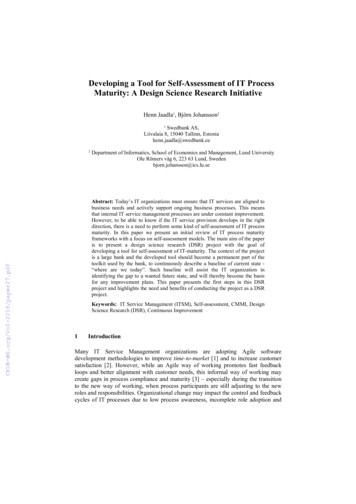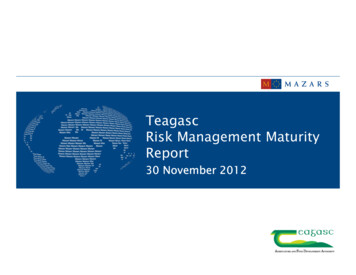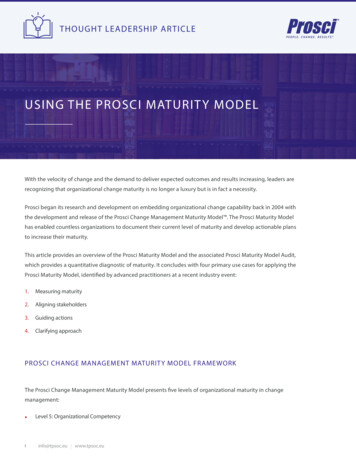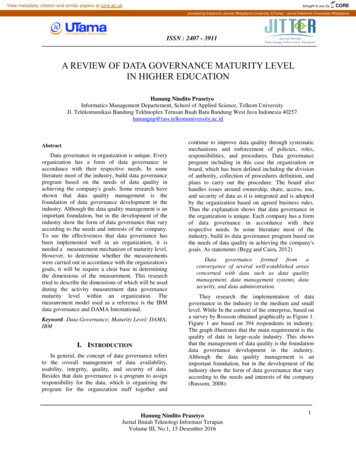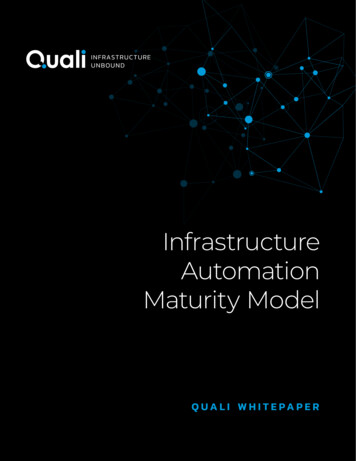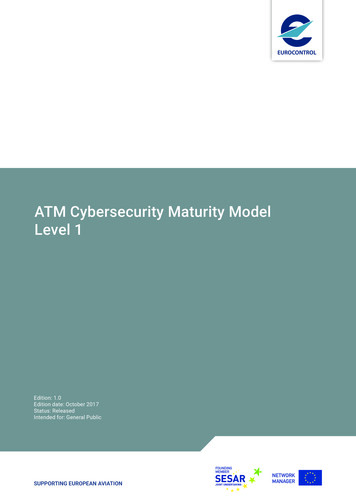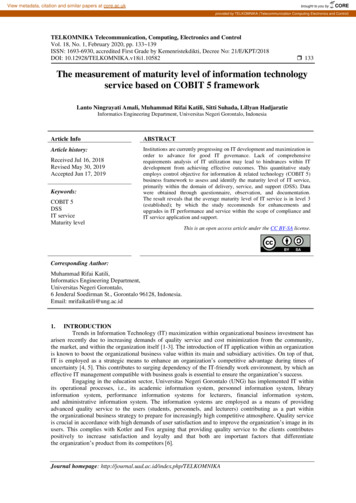
Transcription
View metadata, citation and similar papers at core.ac.ukbrought to you byCOREprovided by TELKOMNIKA (Telecommunication Computing Electronics and Control)TELKOMNIKA Telecommunication, Computing, Electronics and ControlVol. 18, No. 1, February 2020, pp. 133 139ISSN: 1693-6930, accredited First Grade by Kemenristekdikti, Decree No: 21/E/KPT/2018DOI: 10.12928/TELKOMNIKA.v18i1.10582 133The measurement of maturity level of information technologyservice based on COBIT 5 frameworkLanto Ningrayati Amali, Muhammad Rifai Katili, Sitti Suhada, Lillyan HadjaratieInformatics Engineering Department, Universitas Negeri Gorontalo, IndonesiaArticle InfoABSTRACTArticle history:Institutions are currently progressing on IT development and maximization inorder to advance for good IT governance. Lack of comprehensiverequirements analysis of IT utilization may lead to hindrances within ITdevelopment from achieving effective outcomes. This quantitative studyemploys control objective for information & related technology (COBIT 5)business framework to assess and identify the maturity level of IT service,primarily within the domain of delivery, service, and support (DSS). Datawere obtained through questionnaire, observation, and documentation.The result reveals that the average maturity level of IT service is in level 3(established); by which the study recommends for enhancements andupgrades in IT performance and service within the scope of compliance andIT service application and support.Received Jul 16, 2018Revised May 30, 2019Accepted Jun 17, 2019Keywords:COBIT 5DSSIT serviceMaturity levelThis is an open access article under the CC BY-SA license.Corresponding Author:Muhammad Rifai Katili,Informatics Engineering Department,Universitas Negeri Gorontalo,6 Jenderal Soedirman St., Gorontalo 96128, Indonesia.Email: mrifaikatili@ung.ac.id1.INTRODUCTIONTrends in Information Technology (IT) maximization within organizational business investment hasarisen recently due to increasing demands of quality service and cost minimization from the community,the market, and within the organization itself [1-3]. The introduction of IT application within an organizationis known to boost the organizational business value within its main and subsidiary activities. On top of that,IT is employed as a strategic means to enhance an organization’s competitive advantage during times ofuncertainty [4, 5]. This contributes to surging dependency of the IT-friendly work environment, by which aneffective IT management compatible with business goals is essential to ensure the organization’s success.Engaging in the education sector, Universitas Negeri Gorontalo (UNG) has implemented IT withinits operational processes, i.e., its academic information system, personnel information system, libraryinformation system, performance information systems for lecturers, financial information system,and administrative information system. The information systems are employed as a means of providingadvanced quality service to the users (students, personnels, and lecturers) contributing as a part withinthe organizational business strategy to prepare for increasingly high competitive atmosphere. Quality serviceis crucial in accordance with high demands of user satisfaction and to improve the organization’s image in itsusers. This complies with Kotler and Fox arguing that providing quality service to the clients contributespositively to increase satisfaction and loyalty and that both are important factors that differentiatethe organization’s product from its competitors [6].Journal homepage: http://journal.uad.ac.id/index.php/TELKOMNIKA
134 ISSN: 1693-6930Limited resources (e.g., application, information, technology, facilities, and human resources) areessential elements to consider when implementing IT within an organization, in which it costs anorganization considerably high expense to implement IT [7]. An organization’s capability to conductIT management is the primary determinant of quality of IT service, as it does not solely rely on technology.IT service also involves users and complex processes within. Moreover, an assessment of maturity level of ITservice implementation is critical to identify and measure the extent of quality of IT service in providingeffective management and support to the business process. The assessment involves best practice framework,i.e., COBIT 5 within the domain of delivery, service, and support (DSS).The assessment of maturity level is intended for an organization to identify the maturity level of ITto be used as a benchmark to enhance the quality of IT service and to ensure the availability of IT service inaddressing to current and further business needs. Moreover, the assessment is essential in order forthe organization to be capable of analyzing strength and weakness and to formulate strategies in addressingthe gap, maintaining decent organizational governance, and minimizing potential risks [8, 9]. By that,the organization is expected to be capable in interpreting business target and goals, by which the organizationcan prioritize certain business operational activities, mainly in determining effective IT service to supportthe optimal outcomes of IT governance.a. IT governanceImplementation of IT has been one of the decisive factors in maintaining and broadeningorganizational strategies and goals. This creates a critical dependency of IT within every segment of workenvironment; thus requiring more focused study, mainly on IT governance [10]. The statement is echoed bya global survey result from McKinsey on 2014 reporting that 35 percents of IT executives have agreed thatimproving governance process and supervision is critical to improving IT performance. It is essential for anorganization in public and private sector to perform IT governance effectively, by which the organization isrequired to conduct several adjustments on policy and regulations within macroeconomics and in ICTsector [11]. Consequently, one of the critical determinants to consider in IT governance is to provide steadyand capable IT so that the organization can maintain, support, and to broaden organizational strategiesand goals.IT governance is defined by ITGI as the responsibility of executives and the board of directors;it consists of the leadership, organizational structures, and processes ensuring that the enterprise’s IT sustainsand extends the organization’s strategies and objective [12]. IT governance is the combination ofbest practices of planning & organization, procurement & implementation, delivery & support, andsupervision & evaluation of IT in which it ensures that the organizational information and technology arecapable of supporting the organizational business goals [13]. Moreover, classify IT governance into twoaspects, i.e., functional aspect, involving structure and processes considered as an organizational designelement; and social aspect, which involves human behavior and organizational culture [14]. Based onthe framework, this study defines that IT governance is the whole aspects needed to ensure that IT systemmaintains and broaden organizational strategies and goals, by which IT governance is considered as anintegral part of organizational governance.Surging demands of information within decision-making process have increased the need fora comprehensive IT governance structure [15], for an effective IT governance structure can contribute tothe improvement of organizational business value. This is important as an effective prerequisite tothe organizational governance. Therefore the roles and responsibilities of the parties involved must be clearlydefined [16]. Most of the maturity models used for IT governance are related to the existing businessframeworks. These frameworks only emphasize processes and structures [17]. Of all business frameworks formaturity model, COBIT is the only framework that put its focus on IT governance [14].b. Maturity levelThe Merriam-Webster encyclopedia defines maturity as “the quality or state of being mature.” Inthe meantime, the maturity level is defined as the description of maturity of IT processes within anorganization considered as benchmark and self-assessment tool by IT management in assessing the extent ofmaturity of implementation of IT [18, 19]. Maturity process is among the key elements in COBIT businessframework. It is the assessment tool to determine the extent of IT management process. COBIT frameworkfeatures a maturity model to conduct control on IT processes involving scoring process, by whichthe organization is able to scale its IT processes, ranging from 0 (nonexistent) to 5 (optimized) [12]. Byassessing the level of maturity process, the organization has been made possible to determine whichprocesses are under control and which processes that represent potential management challenges [20].Assessment of maturity level is a part of propriety test on the existing activity and IT processes in accordancewith its level.In COBIT version 4.1, the concept of maturity level applied is capability maturity model (CMM). Itis replaced in COBIT version 5 by the model of process capability based on standards of ISO/IEC 15504TELKOMNIKA Telecommun Comput El Control, Vol. 18, No. 1, February 2020: 133 - 139
135TELKOMNIKA Telecommun Comput El Control(SPICE) - information technology process assessment [21]. COBIT assessment is designed to featurerepeatable, reliable, and valid methodology for the organization to assess the capability of its IT process [21].Model of process capability in COBIT 5 is based on ISO/IEC 15504 (SPICE) by employing ProcessAssessment Model (PAM) method. The model assesses the performance of evaluate, direct, andmonitor-based (EDM) governance processes and plan, build, run, and monitor-based (PBRM) managementprocess, and is capable of identifying sectors that need performance upgrade.Capability process model is employed to ensure that the assessment result is objective, impartial,consistent, repeatable, and able to represent assessed processes [22, 23]. The maturity level in COBIT 5 isexpressed on a scale ranging from 0 (incomplete) to 5 (optimizing), as presented in Table 1 [21].Table 1. Levels to assess the maturity in Cobit 5Capability LevelLevel 0: IncompleteLevel 1: Performed (Informed)Level 2: Managed (Planned and monitored).Level 3: Established (Well defined)Level 4: Predictable (Quantitatively managed)Level 5: Optimizing (Continuousimprovement)AchieveThe process is not implemented or fails to achieve its process purposeThe implemented process achieves its process purpose;The process is managed and results are specified, controlled and maintained;A standard process is defined and used throughout the organization;The process is executed consistently within defined limitsThe process is continuously improved to meet relevant current and projectedbusiness goals.2. RESEARCH METHOD2.1. PlanningResearch plan is the plan and procedure for carrying out researches, involving general assumption,research strategy, a method of data collection, and detailed analysis [24]. Referring to the research plan,the research strategy applied is a quantitative method, involving literature study, observation, andquestionnaire as a technique of collecting data. Moreover, the research employed phases of the research plan(Figure 1), i.e. preliminary study through literature and case study. A literature study was conducted to graspa comprehensive insight of IT governance, management, organization, and COBIT 5 framework. The casestudy took place in UNG by identifying business environment within the organization. From the researchplan this study extracted the requirements, target, and strategic objects in accordance with processes withinDSS domain the result is further treated as a reference in formulating questions within questionnaire form, byalso referring to best practice standard of DSS domain of COBIT 5 framework within ISACA.Literature review andcase studyRequirements, targets,and strategic objectsQuestionnaire designRecommendationGap analysisMaturity levelassessmentFigure 1. Research procedure2.2. Population and sampleSamples were obtained by non-probability sampling by saturated sampling technique due to researchelements were selected randomly and proven capable to comply with pre-existing factors. On top of that,the technique generates result capable of being generalized with minimum errors [25]. The samples wereselected from the population of 57 people consisting of leaders and staffs which qualify the requirements toparticipate in this research. Saturated sampling technique allows the whole population to be treated asa sample. Saturated sampling is defined as a technique for selecting sample if the whole population is treatedas a sample [24]. Therefore, the research also involves the 57 people as its samples.2.3. Instrument formulation and proceduresThe formulation of research instruments for DSS domain is based on PAM model in COBIT 5framework [21]. This domain is related to the actual delivery and required service support which involvesservice, security and maintenance management, service support for the users, and data management andoperational facilities. The assessment scale of every question involved scoring as shown in Table 1.The measurement of maturity level of information technology service. (Lanto Ningrayati Amali)
136 ISSN: 1693-69302.4. AssessmentThis step involved elaboration of the research findings, such as for as the current situation of ITservice management within the organization in every process of DSS domain. During this phase, an analysiswas also conducted to identify any gaps in order to compare and adjust the maturity level with the targetedlevel. The analysis was employed on every process within DSS domain of IT, from which the researchformulates recommendations for further management upgrades of IT service. These recommendationsare further treated as guidelines in formulating upgrades on service processes and support of IT withinthe institution capable of fulfilling and exceeding current and further organizational business needs.3.RESULTS AND ANALYSISThe data analysis step requires normally distributed data in order to ensure the data validity and freefrom any biases.3.1. ResultsBased on p-plot graph normality test, it shows that the data are normally distributed and meetthe requirements for further analyses. When the data follow or approach the diagonal line, the data isconsidered normal to be distributed by examining p-plot diagram, skewness value, and that kurtosis level isin between -2 or 2. The normality test result shows that the data are evenly distributed by skewness value of-0.835 and kurtosis level of 0.085, which is in the range of 2.Moreover, the analysis employs data validity and reliability test. Validity test is defined as a testconducted on research instrument formulated, to measure the extent to which an instrument is able toaccurately assess certain concepts which are needed to be assessed [25, 26]. The instrument is consideredvalid if it can be used to measure what is needed to be measured. The research employed product momentPearson validity test to assess the validity of its instrument. The validity test results in rcount rtable witha significant rate of 5% in between 0.809 and 0.924; therefore, the instrument is considered valid.Further, instrument reliability is related to the uniformity of results when the research object isrepeatedly measured. Reliability is an extent to which errors in the instrument are minimized as possible inorder to produce consistent outcomes [27, 28]. To perform reliability test of research instrument, the researchemploys Cronbach’s Alpha coefficient analysis. The result illustrates that the value of Cronbach’s Alphacoefficient ranges from 0.6 to 0.7 within the acceptable minimum rate of reliability [29]. Referring tothe result of data analysis which shows that Cronbach’s Alpha value is in 0.93, hence, the research instrumentis considered to be reliable.Table 2 illustrates the result of data processing which shows the maturity level assessment of ITservice within DSS domain of DSS01, DSS02, DS03, DSS04, DSS05, and DSS06 process. Figure 2 indicatesthe graph of current, expected and maximum maturity level within DSS01, DSS02, DSS03, DSS04, DSS05,and DSS06 domain process.Table 2. The average score of maturity level within DSS process domainDomain e OperationsManage Service Requests and IncidentsManage ProblemsManage ContinuityManage Security ServicesManage Business Process ControlsMaturity level3.433.313.263.343.343.44Expected level444444Maximum level555555Figure 2. Graph of a DSS process capability levelTELKOMNIKA Telecommun Comput El Control, Vol. 18, No. 1, February 2020: 133 - 139
TELKOMNIKA Telecommun Comput El Control 1373.2. Analysisa. Maturity level assessment of IT serviceFrom the data analysis and the result of maturity level assessment of IT service within processdomain DSS01 to DSS06, it is indicated that:- Process domain DSS01 (manage operations) possesses maturity level of 3.43. The process is in level 3established (well-defined), which denotes that the IT service process has been well-implemented byreferring to the defined standard process and made possible to achieve positive outcomes. The maturitylevel implies that there is a surging need of IT-friendly work environment in managing organizationalprocesses. This is illustrated by the availability of IT devices to support the performance academic andother systems within the organization, e.g., the availability of blade server to support the systems’performance. Within this level, the need for computer operational management is addressed accuratelywithin the organization. In addition, the organization has allocated IT resources and conducted trainingsfor the IT-related personnels. Further, the organization has accurately addressed the need of IT assetmaintenance, by which the organization released limited access policy to allow IT facilities onlyaccessible by certain IT-related personnels.- Within process domain DSS02 (manage service requests and incidents), the maturity level scores3.31, which suggests that the process is in level 3 Established (well-defined). The maturity levelpoints out that the process of the IT service has been implemented by referring to the defined standardprocess; this allows the process to achieve positive outcomes. It is observable from the effective supportby the management board to respond to the need of management system and from the availability offinancial support for the supporting staffs when conducting trainings. Moreover, the organizationhas resolved the need for helpdesk function and service and issue management within the unit.The organization also has prepared users’ guideline for IT service and documentation for everyissue indications.- Within process domain DSS03 (manage problems), the maturity level scores 3.26, which demonstratesthat the process is in level 3 Established (well-defined). The maturity level denotes that the process ofthe IT service has been implemented by referring to the defined standard process and this made possiblefor the process to achieve positive outcomes. It is noticeable from raising awareness of the importance tomanage issues, and from the efforts strived to identify the roots of the issues in IT service. On top of that,the escalation process of handling issues in IT service is standardized. The problem-solving steps haveinvolved issue documentation and identification employed by response team engaging centralized tools.- Process domain DSS04 (manage continuity) possesses maturity level of 3.34. The process is in level 3Established (well-defined), in which it points out that the IT service process has been well-implementedby referring to the defined standard process and made possible to achieve positive outcomes. Thissignifies that the responsibilities for the planning of service continuity and test are clearly defined anddesignated to the respective staffs within the organization. Moreover, the result denotes accountablemanagement of service continuity. IT continuity plans are well-documented referring to critical elementsof the system and organizational business impact. Moreover, the management board performs consistentcommunication with the staffs on the importance of planning to maintain the continuity of IT service. Inthe meantime, the organization has implemented high availability of components and backup system.- Within process domain DSS05 (manage security services), the maturity level scales 3.34 in level 3Established (well-defined). The result illustrates that the IT service process has been well-implemented byreferring to the defined standard process; by which it allows the process to achieve positive outcomes. Itis apparent that the organization possesses comprehensive and awareness of the significance of ensuringthe IT security, in which responsibilities and accountability are determined, managed and understood toensure IT security. Further, the organization has established procedures for IT security in accordance withIT security policy, in which the security report involves coherent business focus. The management boardalso engages steps to minimize and address risks sustainably.- Process domain DSS06 (manage business process control) shows maturity level of 3,44 in level 3Established (well-defined), which symbolizes that the IT service process has been well-implemented byreferring to the defined standard process and made possible to achieve positive outcomes. It is depicted inenhancements by the organization to address issues in information control and development ofcomprehensive management of environmental quality. On top of that, environmental control ofthe organization is engaged proactively, one of which includes a commitment to facilities and awarenessof IT security. The organization also possess a responsible and accountable structure which havethe privilege of access to IT services in accordance with the capabilities and skills required to developtechnology infrastructure plan.The measurement of maturity level of information technology service. (Lanto Ningrayati Amali)
138 ISSN: 1693-6930b.Gap analysis of maturity level of ITThe average results of the assessment of IT service maturity level within the process domainsDSS01 to DSS06 depict current average maturity level on level 3 (Established). It is the condition in whichprocesses of IT service have been implemented by standard procedure and achieved a positive outcome, havecommunicated and implemented by all academicians. Therefore, the organization should enhance itsperformance of IT service, involving policy, implementation, and conformity to progress to level 4 maturity(predictable), as shown in Figure 3 as follows. Moreover, the organization requires to perform adjustments toachieve desired maturity level.The biggest gap occurs in DSS03 (manage problem) domain, in which the maturity level is 3.26.Conversely, the smallest gap is shown in the DSS06 domain, which scales 3.44 in the maturity level.The existing gap within DSS03 domain signifies the lacks of comprehension within every level ofthe organization towards management process on issues of IT service. This is echoed by rather unstablequality of service to users and hindrances due to the personnels’ limited knowledge within eachorganizational unit. Henceforth, the overall result of maturity level assessment of IT service demonstratesthat the current maturity level is quite distant from the desired level, i.e., level 4 (predictable).Figure 3. Radar diagram of DSS process capability levelc.----RecommendationsThis study recommends that:The organization requires to formulate and ratify policy of Standard Operating Procedure (SOP) of ITservice management, due to the deficiency of comprehensive SOP within each organizational unit.The SOP is critical to formulating as a guideline of process and implementation of IT governance withinthe organization. By that, it allows the organization to implement comprehensive and detaileddocumentation of every process, job desk, and role of individuals or groups within the organization.It is crucial for the organization to engage in the clear and well-structured standardization ofgovernance and management to minimize potential gaps in data and information flows needed whenformulating policy.Enhancement in IT service system is essential within every work unit of the organization in accordancewith the characteristics of IT service of each unit.The organization is required to implement integration with pre-existing applications to validate data,from which it provides ease for the users to experience service of the accurate and effectiveinformation accessing.Upgrade and optimization in ICT service system are vital for the organization to conduct to achievegood governance.4.CONCLUSIONThe overall score of the current maturity level of IT service is in scale 3 (established) out oflevel 5 scale (optimizing). The overall result reveals that IT service processes are implemented anddocumented referring to the defined standard process, in which it allows the organization to achieve positiveoutcomes. Despite that, the organization is obliged to enhance the DSS process, due to the current maturitylevel is quite distant from the desired level, i.e., level 4 (predictable). The most significant gap exists inDSS03 (manage problem) domain, in which the maturity level is 3.26. In contrast, the smallest gap is shownin the DSS06 domain which scales 3.44. This signifies the importance of the personnels’ knowledge upgradein handling IT service issues by engaging in training, apprenticeship, and certification. On top of that, itneeds full commitment from all academicians to ensure the information availability and ease of access withinTELKOMNIKA Telecommun Comput El Control, Vol. 18, No. 1, February 2020: 133 - 139
TELKOMNIKA Telecommun Comput El Control 139each work unit. By that, it is essential for the organization to implement well-prepared planning and toexecute the planning consistently in order to comply with organizational strategy and 24][25][26][27][28][29]C.S. Amaravadi, “Digital Repositories for e-Government,” Electronic Government, vol. 2, no. 2, pp. 205-218,2005.E. Novianti and A.N. Fajar, “Information Technology Investment Analysis of Hospitality Using InformationEconomics Approach,” TELKOMNIKA Telecommunication Computing Electronics and Control, vol. 17, no. 2,pp. 609-614, 2019.A. A. Farhanghi, A. Abbaspour, and R.A. Ghassemi, “The Effect of Information Technology on OrganizationalStructure and Firm Performance: An Analysis of Consultant Engineers Firms (CEF) in Iran,” Procedia - Social andBehavioral Sciences, vol. 81, pp. 644–649, 2013.A. Aslizadeh, “Impact of Using Information Technology on Creating a Sustainable Competitive Advantage forCompanies (Case Study: Golestan Food Companies),” Indian Journal of Fundamental and Applied Life Sciences,vol. 4, pp. 1595-1603, 2014.M. Sibanda and D. Ramrathan, “Influence of Information Technology on Organization Strategy,” Foundations ofManagement, vol. 9, no. s1, pp. 191-202, 2017.P. Kotler, Strategic Marketing for Educational Institutions, 2nd ed. New Jersey: Prentice-Hall Inc, 2000.L.N. Amali, M. Mahmuddin, and M. Ahmad, “Information Technology Governance Framework in the PublicSector Organizations,” TELKOMNIKA Telecommunication Computing Electronics and Control, vol. 12, no. 2,pp. 429-436, 2014.M. Ciorciari and P. Blattner, “Enterprise Risk Management Maturity-Level Assessment Tool,” The Society ofActuaries, pp. 1-25, 2008.M. S. de Araujo, E. C. Oliveira, S. B. S. Monteiro, and T. M. F. Q. Mendonça, “Risk Management MaturityEvaluation Artifact to Enhance Enterprise IT Quality,” in Proceedings of the 19th International Conference onEnterprise Information Systems (ICEIS), vol. 3, 2017, pp. 425-432.S. de Haes and W. van Grembergen, “Enterprise Governance of IT, Alignment and Value, in EnterpriseGovernance of Information Technology,” Springer, pp. 1-10, 2015.E. N. Nfuka, L. Rusu, P. Johannesson, and B. Mutagahywa, “The State of IT Governance in Organizations fromthe Public Sector in a Developing Country,” Proceedings of the 42nd Hawaii International Conference on SystemSciences, pp. 1-12, 2009.ITGI, “Executive Overview COBIT 4.1. Rolling Meadows USA: IT Governance Institute,” 2007.H.G. Alberti, “IT Governance and Human Resources Management: A Framework for SMEs,” InternationalJournal of Human Capital and Information Technology Professionals (IJHCITP), vol. 4, no. 3, pp. 1-18, 2013.D. Smits and J. V. Hillegersberg, “IT Governance Maturity: Developing a Maturity Model using the DelphiMethod,” Hawaii International Conference on System Sciences, pp. 4534-4543, 2015.R. Kann, F. Van Der Oord, J. Ugbah, A. Arora, N. Kumar. 2014 Audit Plan Hot Spots, CEB Audit LeadershipCouncil, 2013.W. Van Grembergen and S. De Haes, “IT Governance Structures, Processes, and Relational Mechanisms:Achieving IT/Business Alignment in a Major Belgian Financial Group,” Proceedings of the 38th HawaiiInternational Conference on System Sciences, vol. 38, pp. 1-10, 2005.G. P. Rogers, “The Role of Maturity Models in IT Governance: A Comparison of the Major Models and TheirPotential Benefits to the Enterprise, Information Technology Governance and Service Management: Frameworksand Adaptations,” IGI Global, pp. 254-265, 2009.D. Proença and J. Borbinha, “Maturity Models for Information Systems - A State of the Art,” Procedia ComputerScience, vol. 100, pp. 1042-1049, 2016.O. Matrane, A. Talea, C. Okar, and M. Talea, “Towards a New Maturity Model for Information System,”International Journal of Computer Science Issues (IJCSI), vol. 12, no. 3, pp. 268-278, 2015.P. Weill and J.W. Ross, “IT Gove
maturity model, COBIT is the only framework that put its focus on IT governance [14]. b. Maturity level The Merriam-Webster encyclopedia defines maturity as "the quality or state of being mature." In the meantime, the maturity level is defined as the description of maturity of IT processes within an organization considered as benchmark and .




